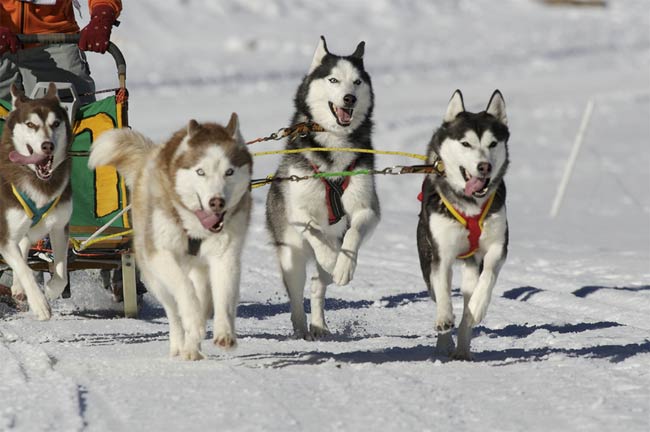Iditarod Dogs' Endurance Secret Revealed

Racing sled dogs could be considered the Lance Armstrongs of the canine world, for their strength and endurance. New research sheds light on how they do it.
Sled dogs are best known for "mushing" each March in the Iditarod Trail Sled Dog Race, the world’s longest sled race. The canine competitors cover 1,100 miles (1,770 km) from Anchorage to Nome, Alaska, sometimes in just nine days.
The dogs often trek through heavy blizzards and endure temperatures as low as minus 40 degrees Fahrenheit (minus 40 degrees C). The chilly conditions are necessary for the dogs, which would overheat in balmier climes. That's because dogs can't sweat, except through their paws, and they generate a tremendous amount of heat purely from the burning of calories during the race.
Michael Davis of Oklahoma State University’s Center for Veterinary Health Sciences has studied the sled dogs for the past 10 years. He runs check-ups on the dogs before and after races as well as during controlled experiments for which he sets up races with groups of sled dogs. The secret to the dogs' feats of day-to-day endurance lies in their ability to "reprogram" their bodies' responses to stress after just one day of competition, something humans can't do.
Davis plans to present his recent findings this week at a conference of the American Physiological Society in Hilton Head, S.C. If you were to attend a race, Davis said, you might be surprised that the dogs are not all purebred Siberian Huskies. Rather, they are mutts, with a mix of Husky, Alaskan Malamute, Pointer and other breeds.
Ultra athletes
Davis found that just like human athletes, conditioned sled dogs show body damage during their first day of exercise.
Get the world’s most fascinating discoveries delivered straight to your inbox.
For instance, when any athlete, canine or Homo sapiens, pounds the pavement or icy ground for miles, bits of muscle enzymes and proteins leak out from their cells. Scientists say this is a sign of cell damage.
Our cells do recover in a day or so, but as soon as we go for another run, the same damage happens all over again.
For sled dogs, that's not the case. "If you then take them out and do exactly the same exercise the following day and the day after that, and the day after that, you don't continue to get that leakage [of enzymes and proteins]," Davis told LiveScience.
He added, "In the course of just a day or two, they manage to adapt their system so that exercise that was injuring a muscle cell here and there on the first day is no longer injuring muscle cells."
Davis found the sled dogs somehow reprogram their bodies after that first or second day of training with an athletic armor of sorts to prevent other bodily stresses as well.
Hungry canines
The four-legged fur-balls also have appetites rivaling any human athlete. During race season, the dogs, which weigh a mere 55 pounds (25 kg), consume 12,000 calories a day, Davis said.
For comparison, Olympic swimmer Michael Phelps reportedly eats some 10,000 to 12,000 calories a day during competitions. But Phelps boasts at least three times the weight of a race dog, Davis said.
"The challenge is getting 12,000 calories into a little dog like that and it has to be very calorie-dense," he said. "While they're racing, they're eating a diet that is pushing between 60 and 70 percent fat."
(Every gram of fat contains nine calories, compared with the 4 calories in a gram of protein or carbohydrate).
Whatever it is that allows sled dogs to chow down on so much fatty food and stay healthy could be beneficial to humans. And so results of Davis' findings have implications for humans who have become obese or developed Type 2 diabetes.
"If you feed a diet that's very high fat to a human, a lot of humans become obese and they develop type 2 diabetes. And the dogs don't," Davis said. "There is no such thing as an obese Type 2 diabetic sled dog despite the fact that they're eating a diet that should produce that."
- Video – Extraordinary Dogs
- Top 10 Amazing Animal Abilities
- Vote for Your Favorite Pet
Jeanna Bryner is managing editor of Scientific American. Previously she was editor in chief of Live Science and, prior to that, an editor at Scholastic's Science World magazine. Bryner has an English degree from Salisbury University, a master's degree in biogeochemistry and environmental sciences from the University of Maryland and a graduate science journalism degree from New York University. She has worked as a biologist in Florida, where she monitored wetlands and did field surveys for endangered species, including the gorgeous Florida Scrub Jay. She also received an ocean sciences journalism fellowship from the Woods Hole Oceanographic Institution. She is a firm believer that science is for everyone and that just about everything can be viewed through the lens of science.


